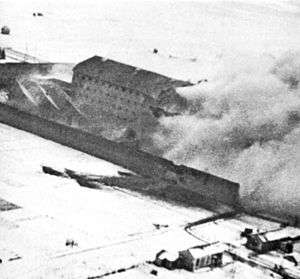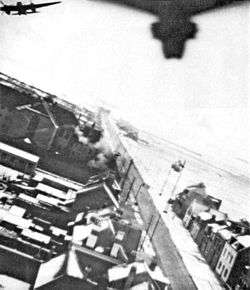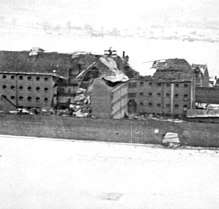Operation Jericho
| Operation Jericho | |||||||
|---|---|---|---|---|---|---|---|
| Part of Second World War | |||||||
 Dust and smoke from Amiens prison during the raid. | |||||||
| |||||||
| Belligerents | |||||||
|
|
| ||||||
| Strength | |||||||
| 9 bombers, 12 fighters |
Anti-aircraft defences 2 Fw 190 | ||||||
| Casualties and losses | |||||||
|
3 Mosquitos, 2 Typhoons aircrew: 3 KIA, 3 POW inmates: 37 KIA, 260 reprisal executions | 50 KIA | ||||||
Operation Jericho[1] was a low-level Second World War bombing raid on 18 February 1944, by Allied aircraft on Amiens Prison in German-occupied France.
The objective of the raid was to free French Resistance and political prisoners.[2] The raid is remarkable for the precision and daring of the attack, which was filmed by a camera on one of the aeroplanes. There is debate as to who requested the attack and whether it was necessary.
Mosquito bombers succeeded in breaching the walls and buildings of the prison, as well as destroying guards' barracks. Of the 717 prisoners, 102 were killed, 74 wounded and 258 escaped, including 79 Resistance and political prisoners, although two-thirds of the escapees were recaptured.[3]
Background
In 1943, many members of the French resistance movement in the Amiens area had been caught by the Germans and imprisoned in Amiens Prison. Some had been betrayed by collaborators and the entire movement in the area was at risk. By December 1943, 12 members of the resistance had been executed at the prison and it was learned that more than 100 other members were to be shot on 19 February 1944. Dominique Penchard began sending information about the prison to London, including details of the layout, defences and duty rosters.[4]
When two Allied intelligence officers were captured and sent to Amiens prison, a precision air attack on the prison was requested and the mission was allocated to the 2nd Tactical Air Force. The prison was next to a long straight road and surrounded by high walls. The guards ate in a building adjacent to the main prison building, making lunch the best time to kill the maximum number of guards. The balance of munitions used had to be arranged so that when hitting the main prison walls, they were breached and the cell doors sprung open without the building being destroyed. As well as destroying the guards' mess hall, the outer walls had to be breached to allow the inmates to escape. There were around 700 inmates in the prison and loss of life was inevitable during an air raid but it was thought that many had already been condemned to death and it would give a chance for some at least to escape.[5]
Attack force

No. 140 Wing of the RAF Second Tactical Air Force, based at RAF Hunsdon in Hertfordshire, was selected to carry out the raid using Mosquito FB Mk VIs. The Wing comprised 18 Mosquitos from No. 464 Squadron RAAF, No. 487 Squadron RNZAF and No. 21 Squadron RAF and was led by the Wing's commander, Group Captain Percy Charles Pickard (DSO and two bars, DFC).
The Mosquitos of 487 Squadron were to breach the outer walls of the prison, while 464 Squadron was to bomb the guard's quarters and the mess hall. No. 21 Squadron was given the unusual assignment of destroying the prison and killing all in it if the first two attacks had been unsuccessful. The raid was to be led by Air Vice-Marshal Basil Embry and was ready to go from 10 February. Close escort was to be provided by Hawker Typhoons from No. 198 Squadron RAF and No. 174 Squadron RAF.
Attack
Embry was originally intended to command the attack but was later forbidden from flying on the mission, as he was involved in the planning of the invasion of Europe. Pickard took his place, despite his limited experience of low-level attack. The mission was delayed by very poor weather, which worsened after 10 February, with low cloud and snow across Europe. By 18 February, it was not possible to wait any longer and the 18 Mosquitos, plus a PR (photo-reconnaissance) Mosquito ("O" for Orange), were prepared. The crews were briefed at 08:00 under high security, the first time they had been made aware of the target. Pickard, in "F" for Freddie, was to bring up the rear of the second wave of aircraft, to assess the damage and to call in 21 Squadron if necessary. In the event of anything happening to Pickard's aircraft, the crew of the PR Mosquito would broadcast the signal instead.

The final decision to carry out the attack was made two hours before the deadline for striking the target and the Mosquitos took off from Hunsdon, into weather worse than many of the crews had previously experienced. Four Mosquitos lost contact with the formation and had to return to base and one had to turn back due to engine trouble, leaving nine to carry out the main attack with four in reserve.
At one minute past noon they reached the target, three of the 487 Squadron aircraft aiming for the eastern and northern walls of the prison, with bombs fitted with eleven-second delayed-action fuses, while the other two made a diversion attack on the local railway station, before returning to the prison. The outer walls were breached but the 464 Squadron Mosquitos were too close behind and had to circle while the bombs detonated.
The eastern wall appeared unbreached at 12:06, when two aircraft from 464 Squadron attacked it from an altitude of 50 feet (15 m), with eight 500 pounds (230 kg) bombs but observers did not see any damage to the prison. Simultaneously, two Mosquitos from 464 Squadron bombed the main building from 100 feet (30 m), also with eight 500 pounds (230 kg) bombs. A direct hit on the guardhouse killed or disabled the occupants and a number of prisoners were killed or wounded, while many were able to escape. Pickard, circling at 500 ft (150 m), saw prisoners escape and signalled the No. 21 Squadron Mosquitos to return home. As he turned for home, hits from a Fw 190 fighter of JG 26 severed the tail of his Mosquito and the subsequent crash killed him and his navigator.[6] A total of 255 prisoners escaped, though 182 were recaptured.[2] The diversion attack on the railway station delayed German reinforcements, sent to recapture the escapees, by two hours.[5]
Controversy
The circumstances involving the request and the true purpose of the mission have remained a secret. While it has been widely believed that the request came from the French resistance, which had members in the prison scheduled to be executed, a post-war investigation by the RAF revealed that resistance leaders were not aware of the raid until the RAF requested a detailed description of the prison.[7]
The raid resulted in over 200 prisoners escaping and killed a number of German guards. However, 102 prisoners were killed in the attack, and many who escaped were later recaptured.
A letter is on record from the head of the Secret Intelligence Service (SIS), Stewart Menzies, thanking the RAF for its execution of the raid. (The letter is signed by "C", a code name for Menzies.) This suggests that the SIS played a role in the planning of the raid. When the head of the SOE's French section, Maurice Buckmaster, was confronted with the fact of the letter signed by "C", he stated that he had never seen it, but that "C" referred to the head of the SIS, Buckmaster said that he had not requested the raid and did not know who had.[7]
A 2011 BBC television documentary on Operation Jericho suggested the raid may have been intended to divert the attention of German military intelligence and away from Normandy, where the D-Day invasion took place a few months later.
List of aircraft involved
| Serial[8] | Pilot | Navigator | Squadron | Notes | |
|---|---|---|---|---|---|
| Mosquito VI (took off 10:50) | |||||
| HX922/EG-F | G/Capt Percy Charles Pickard (KIA) | F/Lt John Alan Broadley (KIA) | 464 RAAF (a/c from 487 sq) | shot down, buried at Amiens[9] | |
| LR334/SB-F | W/Cdr Robert Wilson Iredale, RAAF | F/Lt J L McCaul | 464 | landed 13:00 | |
| MM404/SB-T | S/Ldr A Ian McRitchie (POW) | F/Lt Richard Webb Sampson, RNZAF (KIA) | 464 | failed to return | |
| MM402/SB-A | S/Ldr W R C Sugden | F/O A N Bridger | 464 | landed 13:00 | |
| MM410/SB-O | F/O K L Monaghan | F/O A W Dean | 464 | landed 12:50 | |
| MM403/SB-V | F/Lt T McPhee, RNZAF | F/Lt G W Atkins | 464 | landed 12:50 | |
| LR333/EG-R | W/C I S Smith, DFC | F/Lt P E Barns, DFC | 487 RNZAF | returned | |
| HX892[10]/ EG-T | P/O Maxwell Nicholas Sparks, RNZAF | P/O A.C. Dunlop | 487 | Hit by flak, wheel collapsed on landing, crew safe | |
| HX909/EG-C | P/O M L S Darrell | P/O F S Stevenson | 487 | returned | |
| HX856/EG-H | F/Sgt S Jennings | W/O J M Nichols | 487 | returned | |
| HX974/EG-J | P/O D R Fowler | W/O F A Wilkins | 487 | returned | |
| HX855/EG-Q | F/Lt B D Hanafin | P/O C F Redgrave | 487 | Turned back | |
| DZ414/O | F/Lt Wickam | P/O Howard | PRU | returned | |
| LR403/YH-U | W/C I G Dale | F/O E Gabites | 21 RAF | Instructed not to attack | |
| HX930/YH-C | F/Lt A E C Wheeler | F/O N M Redington | 21 | Instructed not to attack | |
| MM398/YH-J | F/Lt M J Benn | F/O N A Roe | 21 | Instructed not to attack | |
| LR385/YH-D | F/Lt D A Taylor | S/Ldr P Livry | 21 | Instructed not to attack | |
| LR348/YH-P | F/Lt E E Hogan | F/Sgt D A S Crowfoot | 21 | Turned back | |
| LR388/YH-F | F/Sgt A Steadman | P/O E J Reynolds | 21 | Turned back | |
| Hawker Typhoons[11] | |||||
| JR133 | F/O J E Reynaud (POW) | 174 RAF | Failed to return | ||
| JP793 | F/Sgt H S Brown (KIA) | 174 | Failed to return | ||
| JR310 | F/Lt F A Grantham | 174 | Landed at 12.50 | ||
| JP541 | F/Sgt F E Wheeler | 174 | Landed at 12.50 | ||
| JP671 | F/Lt G I Mallett | 174 | Landed at 12.50 | ||
| JP308 | F/O W C Vatcher | 174 | Landed at 12.50 | ||
| JR303 | P/O W D Burton | 174 | Landed at 12.50 | ||
| JP535 | F/O H V Markby | 174 | Landed at 12.50 | ||
| F/Lt R Dall | 198 RAF | Landed 12.50 at Tangmere due to bad weather at Manston | |||
| F/Lt J Scambler | 198 | Landed 12.50 at Tangmere due to bad weather at Manston | |||
| F/Lt R Roper | 198 | Landed 12.50 at Tangmere due to bad weather at Manston | |||
| F/O R Armstrong | 198 | Separated from main formation in snow-storm and returned to base. Landed at 11.30 | |||
| F/Lt R Lallemant DFC | 198 | Separated from main formation in snow-storm and returned to base. Landed at 11.15 | |||
| F/Lt J Niblett | 198 | Separated from main formation in snow-storm and returned to base. Landed at 11.15 | |||
Memorials
A plaque at the prison is dedicated to those who died in the attack and a general airfield memorial is at Hunsdon Airfield, the Mosquito base. On the 60th anniversary in 2004, a Spitfire performed a flypast, as none of the surviving Mosquitos were airworthy.
In film
Mosquito Squadron, a 1969 British war film directed by Boris Sagal and starring David McCallum, was partially inspired by this operation.
Notes and references
- ↑ The eponym is the biblical event when the Wall of Jericho miraculously fell down (Book of Joshua).
- 1 2 "Attack on Amiens Prison, 18th February 1944". RAF. 2004. Archived from the original on 1 January 2007. Retrieved 1 January 2007.
- ↑ "Fact File: Amiens Prison Raid". www.bbc.co.uk British Broadcasting Corporation. Archived from the original on 2012-07-24.
- ↑ Martin, Jonathan, dir. "Prison Busters." Great Raids of WWII. BBC. 2006. Television.
- 1 2 Birtles, Philip (2006). Mosquito Fighter Squadrons in Focus. Red Kite/Air Research. ISBN 0-9546201-3-5.
- ↑ Sedgwick, Philip (17 February 2017). "Leyburn RAF ace Alan Broadley died on mission to save others". Darlington and Stockton Times. Retrieved 1 August 2017.
- 1 2 Shaw, Martin (23 October 2011). "Operation Jericho". BBC. Retrieved 1 August 2017.
- ↑ Lax, Mark (2005). The Gestapo Hunters. Banner Books. ISBN 1875593195
- ↑ Casualty details—Pickard, Percy Charles, Casualty details—Broadley, John Alan, Commonwealth War Graves Commission. Retrieved on 5 November 2008. "Archived copy". Archived from the original on 13 February 2011. Retrieved 13 February 2011.
- ↑ Key Publishing (2009). Mosquito Flypast Special. Key Publishing. ISBN 978-0-946219-18-6
- ↑ Franks, Norman L (2000). RAF Fighter Command Losses of the Second World War - Volume 3. Midland Publishing. p. 20. ISBN 1-85780-093-1.
Further reading
- Fishman, Jack (1983). And the Walls Came Tumbling Down. London: MacMillan. ISBN 0-02-538470-8.
- Lyman, Robert (2014). The Jail Busters. London: Quercus. ISBN 978-1-78206-536-4.
See also
- Aarhus Air Raid, a similar attack on Gestapo headquarters in Aarhus, Denmark
- Operation Carthage, a similar attack on Gestapo headquarters in Copenhagen, Denmark
- Oslo Mosquito raid, a similar attack on Gestapo headquarters in Oslo, Norway
External links
| Wikimedia Commons has media related to Operation Jericho. |
|
|